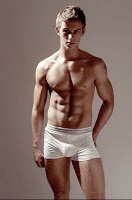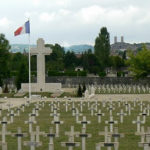Intro: From international pariah under apartheid to world class human rights leader, South Africa has made the most remarkable turn-around of any country in the 20th century. Lesbigays are protected by a new constitution and now celebrate true and equal diversity with other minorities.
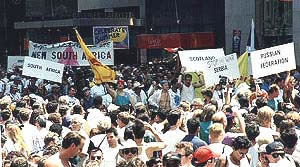
By Richard Ammon
Updated March 2012
Gay Pride
For me, no single act presented the New South African more than the proud 1994 entry of Team South Africa into the opening ceremonies for Gay Games IV in New York. Although not excluded from previous games (unlike the Olympics), this was a justifiably righteous celebration of victory over the dark forces of apartheid that had smothered their country and their gay culture for nearly half a century.
Waving the integrated colors of their ‘New South Africa’ flag high over head, the beaming team of athletes jabbed their banners high to demonstrate clearly their breakthrough into a new dawn of freedom.
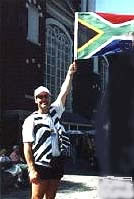 Seeing the South Africa name sign that announced the team’s entrance, the 50,000 spectators rose to their feet and roared their welcome. It reminded me of the wet-eyed standing ovation that newly united Team Berlin received at the Games in 1990.
Seeing the South Africa name sign that announced the team’s entrance, the 50,000 spectators rose to their feet and roared their welcome. It reminded me of the wet-eyed standing ovation that newly united Team Berlin received at the Games in 1990.
I felt a chill down my back as I watched fists shoot into the air; other hands made the victory sign and still others cheered with arms raised high.
There were only eight athletes, but it might as well have been eighty. They represented the present tense of freedom and the future of human rights. Had the New York crowds fully realized that the South African parliament, almost at the same moment, was constructing the world’s finest constitutional privileges for its gay and lesbian citizens, they would have shouldered Team South Africa to the front of the long procession.
Night Life, Day Life
Since that glorious entry, gay South Africa has never looked back.
Lesbigay life in the new South Africa is as busy–or quiet– as one wants to make it. There are more choices, more activity, more color, music, activism, reading, films, dancing and support than ever before. There are gay and lesbian centers and support groups across the entire country.
Reborn gay Christians can call the Atara Mission in Johannesburg. Married gay men can call Fata Morgana support group. The Deaf Association for the Gays of Southern Africa can be found in Pretoria. The Lesbian Action Project can be found in Capetown. Contact lines for counseling information and meetings are in Durban, Kimberley, Bloemfontein, Queenstown and Port Elizabeth.
Capetown, Pretoria and Jo’burg have the widest selection of venues for religious, social, political and medical activity. HIV care related services are broadly available. The Aids Information and Counseling Centre (ATICC) has offices in fifteen different cities.
For those into the party and dance scene there is a generous choice of fab clubs and local bars, especially in the largest urban areas. Informative listings and opinions are easily found in the gay media such as ‘Exit’ newspaper and ‘Out Africa’ magazine.
In the black township of Soweto, where homophobia is so strong, there is a gay friendly ‘shebeen’ (club)-“tell Mando that Bev Ditsie of ‘Outright’ sent you”, I was told.
For film buffs there is the Out in Africa Film Festival in Jo’burg which screens art and homo-theme films during the year. In September, in Capetown, and again in November there are film festivals with a wide international selection.
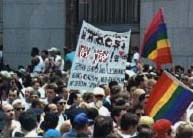 In the Streets
In the Streets
Gay Pride month in South Africa. What originally started in 1990 as a march of protest has become much more of a celebration of lesbigay life in its infinite forms, from colorful floats to single flag wavers, dykes on bikes to lipstick lezzies, leather-strapped strippers to preppie-looking physicians. In Capetown the Pride events are held in March. In Johannesburg October is Pride month.
Activism here also includes protesting at airports–especially when a foreign homophobe flies into the country. President Robert Mugabe of Zimbabwe is convinced that homosexuality is not a natural African trait. For his ignorance he was not welcomed here and in the past he was sent scurrying out the back door of the airport when he arrived. Hundreds of gays and lesbian staged protest against his bigoted slander against homosexuality, creating an event that received worldwide attention in the press. But now he is gone, long overdue, ansdwe will see what the new President has in mind for LGBT folks.
On Television
The visibility of these activities was not just confined to the streets where the cheers, costumes and protests are. After dinner at friends Tony and Jonathan’s in Jo’burg, we watched prime time coverage of recent gay activity in South Africa.
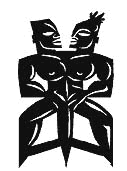 The program covered the recent Gay Pride weekend celebration as well as the Mugabe demonstration with interviews of some protestors explaining the offenses Mugabe had committed. Following this report were clips showing a popular disco where an intrepid reporter interviewed a black transvestite as she/he explained how he/she hustles for a living. The main complaint was feeling harassed by the police based on alleged racial prejudice: “this is not my permanent profession; I only do it for the extra money…it’s not right that we get harassed but they don’t bust any white ladies!”
The program covered the recent Gay Pride weekend celebration as well as the Mugabe demonstration with interviews of some protestors explaining the offenses Mugabe had committed. Following this report were clips showing a popular disco where an intrepid reporter interviewed a black transvestite as she/he explained how he/she hustles for a living. The main complaint was feeling harassed by the police based on alleged racial prejudice: “this is not my permanent profession; I only do it for the extra money…it’s not right that we get harassed but they don’t bust any white ladies!”
Such protest would previously have swept this person off the streets into a locked cell. Now loud and clear it was a legitimate gripe voiced across the airwaves of this New Nation.
To watch the show, our four hosts had piled onto Tony and Jonathan’s bedroom where the TV is located. I thought to myself how familiar this is. How we create our own chosen extended families, eat with them, go hiking, plan our houses and huddle together on a bed to watch a televised program on gay and lesbian life.
Those of use fortunate enough to live in gay friendly urban areas of California are very prone to positive assumptions and easy choices about gay visibility and tolerance. I had to remind myself that we were halfway around the world in a country that has just broken through a choking cocoon and was still surrounded by primitive and repressive third world neighbors like Zimbabwe and Mozambique.
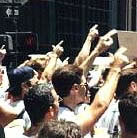 Yet here we were in a ‘guppy’ (gay yuppie) bedroom watching thousands of lesbigay celebrants flash and prance (and quietly walk) down the streets of South Africa. They were protesting the high-level bigotry of a few political leaders and police treatment–and doing it with the pride, silliness, sensitivity and determination we have shown in America for a generation.
Yet here we were in a ‘guppy’ (gay yuppie) bedroom watching thousands of lesbigay celebrants flash and prance (and quietly walk) down the streets of South Africa. They were protesting the high-level bigotry of a few political leaders and police treatment–and doing it with the pride, silliness, sensitivity and determination we have shown in America for a generation.
This was a televised scene that was forcefully forbidden five years ago. Now these South Africans were marching loudly with the legal protection to do so. Awkward and fledgling as the parades were, they nevertheless demonstrated a new freedom and dignity. What we all knew was right, South Africa was showing how to do right.
In The Press
Almost everyday as we crossed the country we read various local newspapers from the Cape to Pretoria. The major story in 2010 is the soccer World Cup held in various stadiums in South Africa. During our visit there was a positive review of the gay/AIDS-themed play ‘The Night Larry Kramer Kissed Me” being staged in Capetown.
A couple of days later, another major story appeared about tourists being mugged in the Transkei area (through which we drove with no trouble, passing through two police checks). This story was followed by an article, in a Durban paper, about the protest against Mugabe at the airport. It further reported on the repressed gay life in Zimbabwe under Mugabe and his bankrupt homophobic regime.
A third major story during our visit was the Pope’s visit to Johannesburg and his outdoor mass for a two hundred thousand people. This was followed by gay related articles, which included coverage of the Gay Pride marches in the major cities. It made for colorful reading: the Pope in scarlet and the gays in lavender. Perhaps we are not equal in numbers with the Pope’s legions, but we are equally colorful in the media.
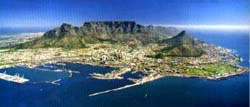 Out in Public
Out in Public
Capetown is the San Francisco of South Africa. Set by the ocean and backed against a dramatic mountain, many consider it to be the gay capitol of the country. Although there is no concentrated Castro district, there is a confident attitude and plenty of action for gay and lesbian residents who live scattered throughout the city and suburbs. Friends celebrate in clubs, bars and mostly at home where we were hosted by a hearty senior white gay couple, Freddie and Michael, long-time residents of Capetown. Both retired, they had been together for forty-five years and had seen the “worse and best if times” as South Africa emerged out of apartheid to a new nation with constitutional equality for all citizens including LGBTs. Sitting in their upper middle class home with its overstuffed sofa and chairs, oriental carpets, fine paintings–and protective cages on the doors and windows. These two warm and playful gents regaled us with stories of the ‘old days’ when there was a large secret gay society that lived well and privately with no violence or harm “because no one knew we were here” laughed Freddie.
They regularly go out to the theatre and the opera. We attended a performance of ‘Cabaret’ with their dear friend Retha. During the show there were various artistically staged scenes involving nudity, which made the performance bold and impactful.
Such scenes would not have appeared before, noted Retha. After the show, returning to our car, we walked behind a young male couple whose hands were securely tucked into each others back pockets. As Freddie and Michael correctly observed, the younger generation feels much freer and acts more boldly than ever. Change was happening right before the eyes of this venerable older couple and they liked it. Freddie lightly tapped Michael on the shoulder to make sure he saw the young pair.
It’s easy to access Capetown’s lesbigay venues and occasions. Copies of ‘Exit’ 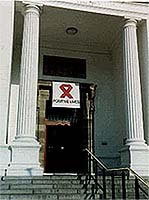 and ‘Out Africa’ are no longer hidden behind the counter. Clubs and bars have quietly survived the ravages of apartheid to become more open and playful in their decor and advertising.
and ‘Out Africa’ are no longer hidden behind the counter. Clubs and bars have quietly survived the ravages of apartheid to become more open and playful in their decor and advertising.
The next day I walked to the National Gallery of Art, next to the Parliament building. Displayed on a large white banner over the front entrance was a bright red AIDS ribbon with the caption “Positive Lives–Responses to HIV”. This powerful display brought HIV out of the closet. Spread across half a dozen galleries inside were hundreds of photographs, narratives and testimonials about life with HIV.
A somber mood was quickly imposed in the first gallery where a large white candle burned in memory of deceased victims. Face after face–black, white, colored, male, female, old, and young–all smiled or grimaced from out of the pictures in a flowing stream of frail hope and chronic agony.
images in other galleries focused on various themes: families, hospitals, religion, and ‘people we love’. A posted statement by the Department of Health boldly announced: “90% of all cases are transmitted by heterosexual contact and from mother to infant…poverty, inequality and discrimination increase vulnerability to HIV infection…the infection rate doubles every 13 to 15 months…the task is to be better informed.” (As of 2001, RSA has over four million infected–10% of the entire population. Finally, cheap medication is now available, after years of protest.)
In the final gallery were brochures and literature (in English and native languages) for free, along with a large bowl of condoms. It was a show of determination and respect in confronting this great threat, but the message was not about to leap into the minds of the most needy: during my hour stay, there were only five other visitors.
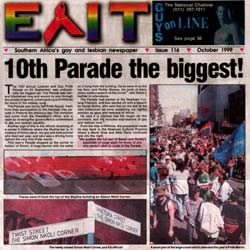
Journals
‘Exit’ is “South Africa’s gay and lesbian newspaper” published every month (as of 1996) in Johannesburg. It reports on gay events, gossip and important issues, such as the recent launch of M2M website. The M2M website offers non-judgemental advice and information about male sexuality, safer sex and sexual health for men who have sex with other men. M2M website.
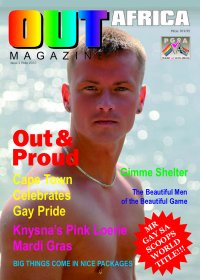 ‘Gay Pages’ Over the past years, the Gay Pages has established itself as the largest, most widely read gay publication in South Africa. Through these pages Gay Pages offers advertisers the opportunity to reach the most affluent sector of the gay market. Their goal is to promote business and to allow the gay (or not so gay) public to meet and conduct business.
‘Gay Pages’ Over the past years, the Gay Pages has established itself as the largest, most widely read gay publication in South Africa. Through these pages Gay Pages offers advertisers the opportunity to reach the most affluent sector of the gay market. Their goal is to promote business and to allow the gay (or not so gay) public to meet and conduct business.
There is now also a Cape Town based glossy called ‘OUT Africa’. On their Facebook page they say, “OUT Africa magazine is a shiny new gay glossy quarterly magazine coming to you from Cape Town, bringing you news and stories that you want to read.”
Books
I was curious to visit a quality mainstream bookstore in Capetown. We were directed to the chain store Exclusive Books in one of the new upscale shopping malls on the stylishly restored Victoria and Albert Waterfront harbor development. What kind of selection did they offer in gay and lesbian literature? Were there any South African authors?
The answer was good and bad. There were many good books on the shelves in their clearly labeled Gay and Lesbian section: mostly non-fiction history, psychology, spirituality, HIV and AIDS information, with only a small gathering of fiction. But all of it was imported, mostly from America.
I asked the clerk at checkout if there were any South African gay or lesbian authors whose books they sold. He looked puzzled, turned and asked another clerk who shook his head. “Not that I know of,” he said. I left, thinking there was some good work yet to be done here.
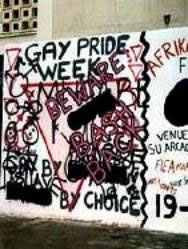 That is, until I looked further. In a gay magazine I found numerous native authors listed in a “Proud, Gay Reading” list. Printed in English and Afrikaans were listed such titles as ‘Gewes Is Alles Net’N Grap En Ander Stories’ (Knowing Is Not Enough and Other Stories) by Hennie Aucamp. Other titles were ‘The Practice of Love–Lesbian Sexuality and Perverse Desire’ by Teresa de Lauretis; ‘Soos Honde Van Die Hemel’ by Marzanne Leroux-Van Der Boon; ‘Male Homosexuality in South Africa–Identity Formation, Culture and Crisis’ by Gordon Isaacs and Brian McKendrick; ‘Defiant Desire–Gay and Lesbian Lives in South Africa’ Edited by Mark Gevisser and Edwin Cameron; ‘Die Soft Rock Club’ by Daniel Botha; ‘More Man Than You’ll Ever Be’ by Joseph Goodwin; ‘Heavenly Love–Lesbian images in 20th Century Women’s Writing’ by Gabrielle Griffin and ‘The Invisible Ghetto–Lesbian and Gay Writing from South Africa’ edited by Mathew Krouse. The list gave me much relief –and much to read.
That is, until I looked further. In a gay magazine I found numerous native authors listed in a “Proud, Gay Reading” list. Printed in English and Afrikaans were listed such titles as ‘Gewes Is Alles Net’N Grap En Ander Stories’ (Knowing Is Not Enough and Other Stories) by Hennie Aucamp. Other titles were ‘The Practice of Love–Lesbian Sexuality and Perverse Desire’ by Teresa de Lauretis; ‘Soos Honde Van Die Hemel’ by Marzanne Leroux-Van Der Boon; ‘Male Homosexuality in South Africa–Identity Formation, Culture and Crisis’ by Gordon Isaacs and Brian McKendrick; ‘Defiant Desire–Gay and Lesbian Lives in South Africa’ Edited by Mark Gevisser and Edwin Cameron; ‘Die Soft Rock Club’ by Daniel Botha; ‘More Man Than You’ll Ever Be’ by Joseph Goodwin; ‘Heavenly Love–Lesbian images in 20th Century Women’s Writing’ by Gabrielle Griffin and ‘The Invisible Ghetto–Lesbian and Gay Writing from South Africa’ edited by Mathew Krouse. The list gave me much relief –and much to read.
Video
Another venue in Capetown’s gay and lesbian district is Wet Warehouse that offers products for the “discreet and up-market adult”.
“There is no gay South African porno,” the owner explained, looking across at the hundred or so imported videos on his shelves. “No one is willing to make these films for fear of exposure. Someone’s mother might see him!”
So he has to import his offerings, which, unlike years ago, are no longer stopped by customs officials. He has recently opened a similar shop in Jo’burg, noting that there were also gay video venues in Durban and Pretoria. Along with the usual films, sex toys and magazines, I noticed that inhalants were available here for about ten dollars, along with ‘male developers’, lingerie (for straights?), and hardcore books and novels. “The products and community are there. It’s a matter of marketing more openly now that we have the right to do so,” he said.
HIV
The plague started on the African continent and it is still devastatingly rampant. In some of the urban areas of neighboring countries, the infection rate is as high as 40% of the population.
Of course, the poorest suffer most and South Africa’s black community has been the hardest hit and the most difficult to educate. The previous government did little to move actively against the disease and ignorance. With Mandela’s election there has been a significant increase in funding and resources for education and care.
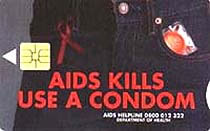 However, availability and application can be far apart, as Giles Griffin knows only too well. “Accessing the black townships is very difficult for us. No one wants to hear about AIDS. We have to break through racial, cultural, religious and language barriers to get the message out to people who don’t want to listen.” Such is the challenge he describes as an HIV prevention manager for ASET (AIDS Support and Education Trust), which operates out of offices in the Capetown suburb of Salt River. ( It’s in the same barb-wire-protected building as the ANC party headquarters where occasional toi-toi native singing can be heard during their meetings.)
However, availability and application can be far apart, as Giles Griffin knows only too well. “Accessing the black townships is very difficult for us. No one wants to hear about AIDS. We have to break through racial, cultural, religious and language barriers to get the message out to people who don’t want to listen.” Such is the challenge he describes as an HIV prevention manager for ASET (AIDS Support and Education Trust), which operates out of offices in the Capetown suburb of Salt River. ( It’s in the same barb-wire-protected building as the ANC party headquarters where occasional toi-toi native singing can be heard during their meetings.)
Giles continued, “we have all the information, but we can’t reach them. We have practically no one on our staff who speaks Xhosa or Zulu (the two main tribal languages). Yet it is estimated that 40% of the black Zulu population in Natal (around Durban) are infected. They don’t want to know about condoms and they don’t want to talk about sex.” To be gay or lesbian in these types of communities is even more taboo so directing specific education at them is like searching the sea with a flashlight. There is just too much darkness.
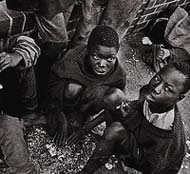 Many black people are Muslim, which unequivocally condemns homosexuality, further distancing actual and potential victims of HIV.
Many black people are Muslim, which unequivocally condemns homosexuality, further distancing actual and potential victims of HIV.
But ASET bravely pushes forward with its educational purpose, working with such receptive organizations as Planned Parenthood, Triangle Health Care (a gay and lesbian health project), the Department of National Health AIDS Program, SWEAT (Sex Workers Education and Advocacy Taskforce) and student groups at the universities. “We offer safe-sex workshops, HIV testing, self-esteem workshops, educational seminars,” continued Giles.
“Downstairs in our clinic we have two doctors, two psychologists, two social workers and a case manager. There are two phone help lines and we get some government funding for advertising. Some small inroads have been made into the gay and lesbian community in the black townships in the form of ‘Abigail’, a discreet social organization that meets casually monthly where some educational material is dispersed.
On the radio airwaves every Saturday evening is ‘In the Pink’, a program aimed at the gay population. Although not directly connected with ASET, they do broadcast news and information about HIV matters. Having broken through political repression and now facing cultural and religious barriers to their message, the various HIV organizations have one of the most difficult health and educational challenges facing the new South Africa–AIDS and ignorance.
And Finally
We drove four thousand miles in three weeks across a country whose area is about the size of our southeast–from Philadelphia to New Orleans to Miami. The landscape varies from moonlike barren plains to rugged escarpment cliffs thousand of feet tall to vast rolling verdant hills of wheat, alfalfa and dazzling spring flowers.
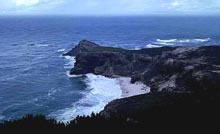 Flying out over the Indian Ocean on our return home, I had knew that a phoenix had arisen in South Africa–and that it was going to fly. New life has emerged from the crumbling absurdity of totalitarian rule. Apartheid was dead, communism was sputtering. As with any new birth there would be new pain but much more new hope: the “new” South Africa.
Flying out over the Indian Ocean on our return home, I had knew that a phoenix had arisen in South Africa–and that it was going to fly. New life has emerged from the crumbling absurdity of totalitarian rule. Apartheid was dead, communism was sputtering. As with any new birth there would be new pain but much more new hope: the “new” South Africa.
Also see:
Gay South Africa News & Reports 2000 to present
Gay South Africa Photo Galleries

